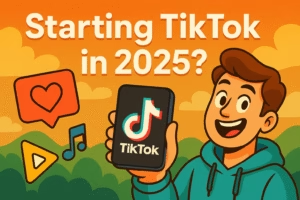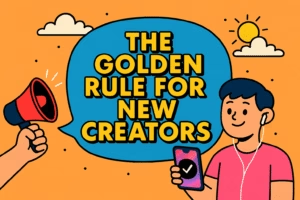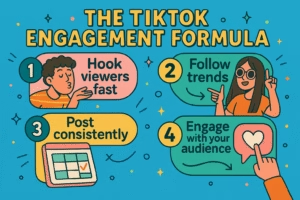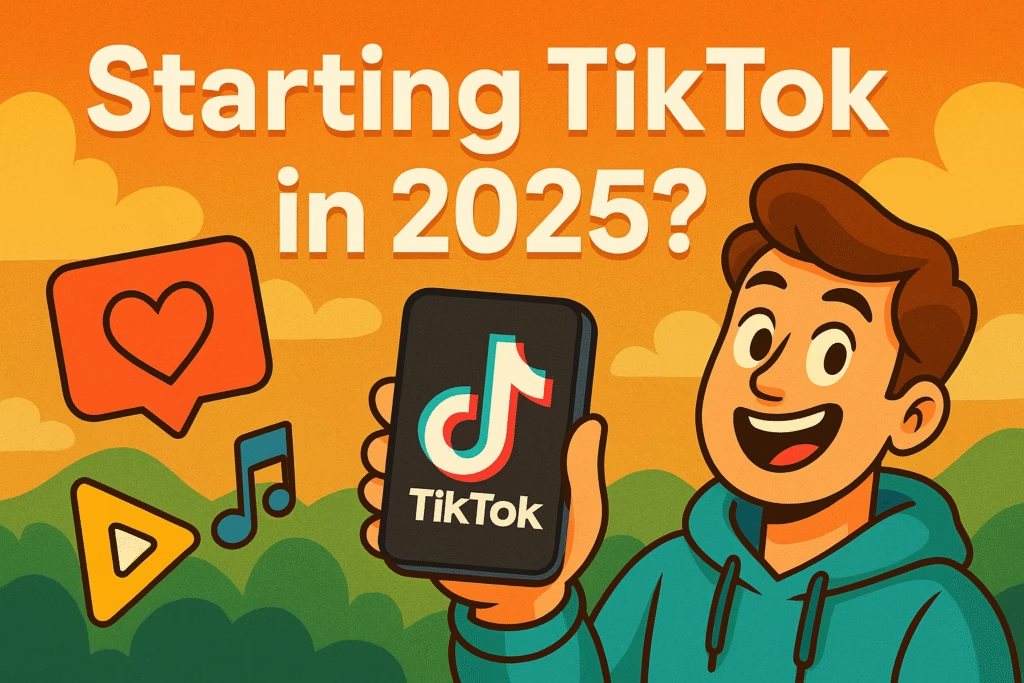You’re starting TikTok next week? Good. Start today instead.
Because here’s the truth no one tells beginners: TikTok doesn’t reward effort. It rewards momentum. The platform favors creators who post a lot, test constantly, and learn fast. Your first 10 videos won’t go viral. They’re not supposed to. They’re your training wheels. Your crash test dummies. Your permission to suck.

The algorithm isn’t looking for perfect content — it’s looking for signals. Engagement, retention, comments, watch loops, fast hooks. You can study all month… or you can post, watch what hits, and learn 10x faster than anyone still waiting to “launch right.”
This guide breaks down what’s working in 2025 — based on creators who are actually growing right now. No fluff. No recycled Instagram strategies. Just practical moves that get you views, engagement, and real followers without dancing in your kitchen or begging strangers to follow back.
The Golden Rule for New Creators: Hook Fast or Get Buried
The first two seconds of your TikTok are make or break. That’s not an exaggeration — it’s math. TikTok’s For You Page gives your video about 150–200 impressions in its first wave. If users don’t stop scrolling? You’re done. That video flatlines in real time.
So what makes someone stop scrolling?

A hook. Not an introduction. Not a slow pan. A punch. A question. A twist. Something that grabs the brain and says, “You need to watch this now.”
Best-performing hooks in 2025 include:
-
“You’re doing [X] wrong — here’s why.”
-
“No one’s talking about this but…”
-
“This is what happens when you [do something relatable or extreme].”
-
“Watch till the end. You won’t believe what happens.”
Notice the pattern? Tension. Curiosity. Conflict. That’s the holy trinity of scroll-stopping hooks.
If your first frame starts with “Hey guys, just wanted to share…” — you’ve already lost. People don’t wait around to be impressed. They wait to be interrupted. Give them a reason.
Want to train this skill fast? Watch the first 3 seconds of the top 20 videos on your For You Page every day. You’ll see the same psychology at work, over and over. Copy the format. Add your twist. Then test it.
The Type of Content That Actually Performs for Beginners (No Fancy Gear Needed)
You don’t need a DSLR. You don’t need studio lights. You don’t even need to show your face. What you do need is content that delivers value fast — and keeps delivering every few seconds. That’s what drives watch time, the biggest ranking factor on TikTok right now.
Here’s what works best for new creators:
1. Relatable mini-stories
Quick anecdotes. Day-in-the-life chaos. Pet peeves. Confessions. These are easy to film and insanely shareable. Bonus points if it’s:
-
Personal
-
Funny
-
Unexpected
Example: “When you work from home and your boss schedules a 7am Zoom.”
2. Screen-recorded tutorials
TikTok LOVES how-to content, especially in:
-
AI tools
-
Canva hacks
-
Productivity tricks
-
Side hustle breakdowns
Don’t worry about your voice. Use text overlays + trending sound. Keep the video 15–30 seconds. One clear takeaway per post.
3. Text-based rants or opinions
This one’s underrated. You type out a bold opinion (“Unpopular opinion: 9-to-5 jobs are more secure than freelancing”), overlay it on stock footage or a looping clip, and post. You’ll attract debate, which = comments = reach.
4. Reactions + stitches
Reacting to viral content is a cheat code. Stitch a trending video with:
-
A hot take
-
A correction
-
A wild reaction face
Don’t overproduce. Just speak. Raw = real = effective.
You don’t need to be an editor or influencer. You need to be clear, fast, and consistent. That’s it.
The TikTok Engagement Formula (It’s Not What You Think)
Everyone talks about likes and views. But that’s not what drives growth. Comments and rewatches are the real engine behind TikTok’s algorithm in 2025. If you want to grow, you need to farm interaction — not just impressions.

Here’s the formula that works:
1. Bait Comments (Without Being Cringe)
Ask questions. Start controversy. Leave something unsaid on purpose.
Examples:
-
“This took me 3 hours. Worth it?”
-
“Not everyone’s going to agree with this…”
-
“What would you do in this situation?”
These open loops force people to react — which tells TikTok your video is engaging. More comments = more reach.
2. Trigger Rewatches
Structure your video so the ending loops perfectly into the start. Or hide something visually that’s easy to miss on first watch. Or talk fast. Anything that forces people to say “wait, what was that?” and rewatch.
Rewatches massively boost retention rate — the strongest signal TikTok tracks.
3. Reply to Comments With New Videos
Instead of writing a reply, tap “reply with video.” Not only does this push your original post back onto the feed — it creates new content without needing a new idea. The best creators use this to build entire mini-series off one viral post.
4. Heart Every Comment
TikTok’s algorithm weighs your engagement too. Hearting comments, replying, and pinning the best ones signals that your post is active. That boosts discoverability after the initial push dies down.
Forget chasing likes. Start engineering interaction.
The Posting Schedule That Works for Beginners (And When to Ignore It)
You’ve probably heard this one: “Post 3 times a day.” Sounds great in theory. But here’s the truth — most beginners can’t keep up with that, and worse, they burn out by week two. The real goal isn’t quantity first. It’s consistency.
So here’s the sustainable posting plan that actually works:
Week 1: Post Once a Day, Every Day
Get into the habit. Build creative momentum. It doesn’t matter if the videos flop. You’re training your brain and feeding the algorithm a steady stream of data.
Week 2–3: Test 2 Posts a Day (Max)
Post one in the morning and one at night. Track performance. If one slot is consistently outperforming the other, you’ve found your time window.
Week 4 Onward: Double Down on What Works
If your nighttime videos always do better, skip mornings. If your rants pop but your skits flop, go full rant. Post smarter, not more.
And here’s what most creators never figure out:
You can stop posting for a day or two if your content is underperforming. TikTok resets your push cycle. If your last 3 videos bombed, take a break. Then return with a high-quality post after 48 hours. The algorithm gives it a fresh shot.
Don’t be the person uploading junk three times a day just to hit a number. TikTok doesn’t reward desperation — it rewards patterns. Learn yours.
What Tools Actually Help Beginners Grow Faster (Without Paying for Views)
You don’t need to buy views. You don’t need to run ads. And you definitely don’t need to fall for those shady “growth services” that promise 10k followers in 3 days. What you do need are tools that help you post smarter, analyze faster, and stay consistent without burning out.

Here are the most beginner-friendly (and effective) tools in 2025:
1. Blaze AI — Your Personal TikTok Growth Assistant
Blaze watches what’s trending, writes scripts, finds hashtags, schedules posts, and even adjusts your content strategy based on performance. If you’re starting from scratch, Blaze gives you a content engine on autopilot. It’s the cheat code I wish I had earlier.
2. Flick — The Smart Hashtag Tool for Instagram + TikTok
Yes, TikTok hashtags still matter — not for search, but for targeting. Flick helps you avoid banned or spammy tags and find trending ones that fit your niche. You get better visibility and avoid triggering suppression filters.
3. CapCut — The Editing App That Doesn’t Suck
Even pros use this. Seamless transitions, drag-and-drop captions, and TikTok-native formatting. Free and powerful. If you’re still using TikTok’s built-in editor for complex stuff — stop. CapCut is smoother and safer.
4. The Social Proxy — Avoid Shadowbans When Testing Accounts
If you ever plan to run multiple TikTok accounts (for niches or backups), you need clean IPs. Social Proxy mimics real mobile behavior, so TikTok doesn’t flag you as a bot. It’s also a great way to reset if your main account is throttled.
5. MetaHashtags — Rapid Hashtag Discovery for Instant Engagement
This is perfect when you want quick results. You paste a keyword, and it gives you a stack of hashtags tailored to high-visibility clusters. Great for early traction or when you’re stuck at 0 views.
None of these tools will go viral for you. But they’ll help you spend less time guessing, more time creating, and build real traction way faster.
Final Advice Most Beginners Never Hear (And Why It’s Costing Them Reach)
Most beginners think TikTok is about luck or looks. It’s not. It’s about feedback loops — and most creators never learn to use them.
Here’s what separates creators who grow from those who burn out:
1. You’re Not Building an Audience — You’re Training the Algorithm
The algorithm doesn’t care about your intentions. It cares about patterns. If you post three videos in a row on different topics, it gets confused. But if you post five videos in a row around one niche — boom. You’ve trained it to push your content to the right people.
Pick a lane for your first 20–30 videos. Stick to it like glue. Then experiment after you’ve earned reach.
2. Your Comments Are More Powerful Than Your Captions
Want to drive engagement fast? Leave the CTA (call to action) in the comments. Then pin it.
Example:
Caption: “This took 5 hours…”
Top comment: “Would you have kept going or quit?” 🔥
It works better than begging people to comment in your caption. Try it.
3. Delete Nothing. Learn From Everything.
A “bad” video isn’t a failure. It’s free data. What was the scroll rate? Where did viewers drop off? Did it get comments but no rewatches? Every post teaches you something. But only if you leave it up long enough to learn.
And if you go viral? Study what worked, but don’t copy it blindly. Often it’s the format, not the topic, that made it pop.
4. Post Like You’re Already Big
Big creators don’t hesitate. They don’t over-edit. They don’t apologize for posting. They treat their audience like it’s already there — and that confidence pulls people in.
Start now. Post daily. Watch what works. Adjust. Repeat.
That’s the whole game.


